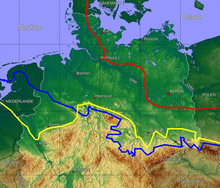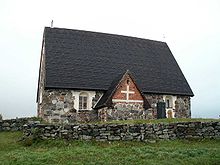Field stone church

‣ red line = ice edge position of the Vistula glacial period ;
‣ yellow line = ice edge of the Saale glaciation ;
‣ blue line = ice edge of the Elster glaciation .
Field stones can only appear in Ice Age areas, especially in the younger ones, i.e. the last ones (yellow and red line).
Stone churches are made of boulders in the area of foundations and foundation walls partly made - boulders - built churches , mostly village churches . The boulders collected in the fields and transported to the field edges are traditionally also called field stones in north-east Germany . One of the most representative examples of a monumental building is the Zinna monastery church .
Field stone churches are often incorrectly referred to as fortified churches , although the technical requirements for this are missing.
distribution

Field stone churches only exist in areas where the ice ages left behind such crystalline debris and which are without natural occurrence of house stones , i.e. poor in natural stone from quarries . In Germany these are Schleswig-Holstein , Mecklenburg-Western Pomerania , Lower Saxony , Saxony-Anhalt , Brandenburg (including Berlin ); in Europe: Scandinavia , Poland , Finland and the Baltic States . The boulders are usually made of granite , gneiss or quartzite and are used both hewn (square) and uncut (often split in half).
history
The field stone churches were mostly built during the late Romanesque and early Gothic periods . Often they are of simple architecture and often village churches . The earliest date from the 11th century. The climax of the field stone church building is to be set towards the end of the 12th century; here the careful cuboid technique dominates . Towards the end of the 16th century, the proportion of unquarified stones and bricks in the masonry increased (so-called mixed masonry ). The corresponding points in time shift in northern Germany with the advance of the German settlement in the east (Christianization); The highlight in Brandenburg is the 13th century. In the course of historicism , they were (very rarely) built at the beginning of the 20th century ( neo-Romanesque ).
See also
- List of stone churches in fishing
- List of field stone churches in Fläming
- Vicelinkirchen in Ostholstein
literature
- Heinrich Ehl: North German Feldsteinkirchen (= Hansische Welt 6, ZDB -ID 530742-9 ). Westermann, Braunschweig a. a. 1926.
- Hans Riediger, Bernd Köhler: Field stone churches, castles and mansions in the area of the Limes Saxoniae. Perten-Druck, Reinbek 1968.
- Viola Pfeifer: Feldsteinkirchen in Fläming. An art history guide. Druckhaus Berlin-Mitte, Berlin 1997, ISBN 3-930541-18-1 .
- Hillert Ibbeken : The medieval field and quarry stone churches in Fläming. Berlin-Verlag Spitz, Berlin 1999, ISBN 3-8305-0039-4 .
- Ralf Gesatzky (ed.): Preservation and repair of field stone churches in Mecklenburg. Thomas Helms Verlag , Schwerin 2001, ISBN 3-931185-68-0 .
- Ernst Badstübner : Field stone churches of the Middle Ages in Brandenburg and Mecklenburg-Western Pomerania. Hinstorff, Rostock 2002, ISBN 3-356-00942-7 .


